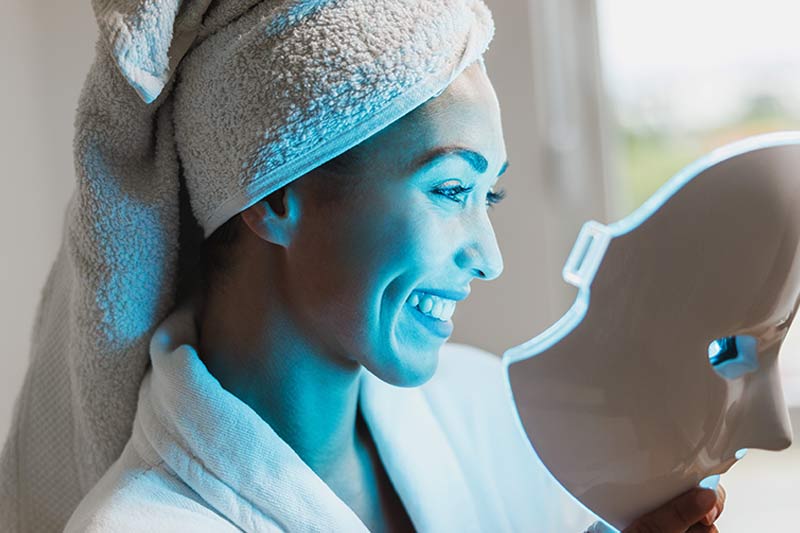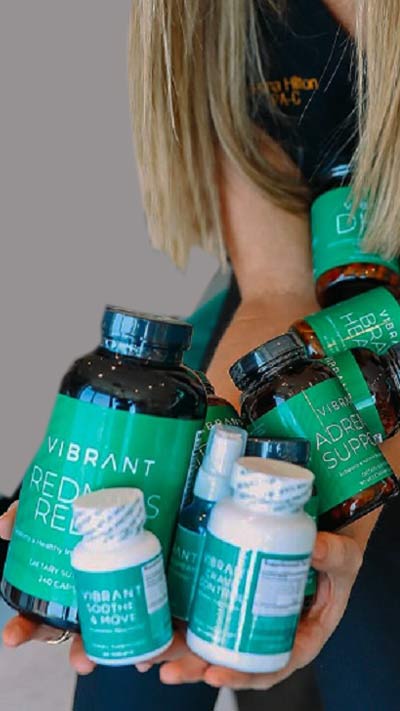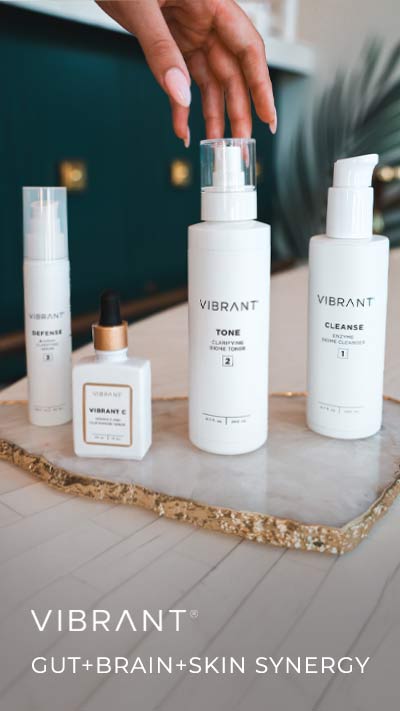Blue light is one of the colors in the visible light spectrum emitted by the sun and various artificial light sources, including computers, smartphones, and LED lights. Extended exposure to blue light can damage our health, particularly the eyes and skin. However, it can also help certain skin conditions. Cosmetic treatments employing blue light have proven effective in treating acne, sunspots, psoriasis, and more.
This article explains how blue light affects the skin, both positively and negatively.

Does Blue Light Affect Skin?
Studies show that the effects of blue light on the skin depend on exposure duration and blue light intensity.
Prolonged exposure to blue light from the sun, electronic and LED devices damages the skin. It stimulates the production of reactive oxygen species (ROS), which degrade skin cells, destroy healthy collagen and elastin, and accelerate aging. However, it can be beneficial as part of medical and cosmetic treatments.
Blue light has the shortest wavelength range of all visible light (380 - 500 nanometers), exhibiting the highest energy. Scientists speculate that short exposure to blue light with lower energy (closer to 420-450 nanometers) exhibits anti-inflammatory and antibacterial properties. It can help treat inflammatory skin diseases (psoriasis, eczema), mitigate acne, and reduce photodamage.
Benefits of Blue Light for the Skin
The benefits of using blue light for cosmetic purposes include:
- Reduced skin inflammation
- Decreased hyperpigmentation
- Balanced sebum production
- Increased collagen production
- Improved skin tone
The skin-enhancing potential of blue light therapy makes it a popular treatment for various skin conditions, including:
- Acne – Blue light reduces the concentration of acne-causing bacteria (Propionibacterium acnes) and balances oil production, helping to mitigate acne breakouts. The therapy can be combined with other acne treatments and medications.
- Psoriasis – Blue light therapy helps reduce the size and intensity of psoriasis patches.
- Atopic dermatitis – Blue light’s anti-inflammatory effects help to mitigate eczema symptoms.
- Non-cancerous skin disorders – Photosensitizing medications and blue light irradiation are used in photodynamic treatment to heal non-cancerous skin tumors, including actinic keratoses, Bowen’s disease, warts, and more.
How Does Blue Light Therapy Work?
Blue light therapy is performed in a dermatologist’s office or a medical spa. At-home devices are also available, but doctors recommend seeking professional help for safer and more effective results.
After their skin is cleansed with acetone, patients put on goggles and sit in front of a U-shaped panel with several LED lights emitting blue light (or a combination of colors). The device is set to a wavelength that’s indicated for the patient’s skin concern, and it heats the target area for 15-30 minutes, enabling blue light to penetrate the skin. The sessions can be performed daily or several times a week until the skin concern is resolved or improved.
Popular Skin Treatments Incorporating Blue Light
The following treatments incorporate blue light for skin concerns:
Blue Light Therapy
Blue light therapy is primarily used to heal acne, treat inflammatory skin concerns, and reduce photodamage. The light penetrates the patient’s skin, inducing anti-inflammatory effects, decreasing redness, and killing acne bacteria. It is a gentle procedure that doesn’t damage the surrounding tissues. The sessions are quick and painless. Phototherapy often combines blue and red light to maximize results.
Note: While blue light helps with surface skin concerns, IPL photofacials are more effective for more pronounced aging signs. Learn how BBL laser treatment, the next-generation IPL therapy, helps reduce wrinkles and rejuvenate the skin.
Photodynamic Therapy (PDT)
Photodynamic therapy is blue light therapy combined with photosensitizing topical medications. It is usually used to treat precancerous growths. Doctors cleanse the patient’s skin, apply topical medication, and leave it on for about 90 minutes. The blue light irradiation activates the medication, killing tumor cells.
At-Home LED Devices
Handheld devices that emit blue LED light may help heal acne and improve skin tone. However, they use lower frequencies and may not provide satisfactory results.
How Effective Are Blue Light Treatments?
Blue light therapy has proven to be very effective in treating acne and it can reduce eczema and psoriasis symptoms. Patients need several treatments to see results.
The therapy’s effectiveness depends on the patient’s unique skin condition and the protocol type – the frequency of sessions, whether they are at home or provided by medical staff, whether blue light is combined with other treatments and medications, etc.
Side Effects of Blue Light Therapy
Blue light therapy is a gentle surface treatment. Patients may experience mild hyperpigmentation that quickly disappears after the treatment.
Photodynamic therapy may cause more side effects, including peeling, scabbing, irritation, and sun sensitivity.
Blue Light and Skin FAQ
The potentially damaging and healing properties of blue light naturally raise many questions about its use in skin care. Here we answer the most frequent ones.
What Does Blue Light Do to the Skin?
Extended exposure to blue light from the sun and electronic devices degrades skin cells and causes premature aging.
Cosmetic and medical treatments incorporating blue light heat the skin and allow blue light to penetrate it to stimulate anti-inflammatory and healing processes. They help reduce acne and inflammation and improve skin tone and texture.
Does Blue Light Age Skin?
Cumulative effects of overexposure to blue light may contribute to early skin aging signs.
Is Blue Light Bad for Skin?
Blue light can be bad for the skin. Use broad-spectrum sunscreens with SPF 30+, antioxidant skincare products, and limit exposure to the sunlight and digital screens to reduce blue light’s damaging effects.
What Are the Benefits of Blue Light?
Blue light has anti-inflammatory, antibacterial, and collagen-enhancing properties, which can help repair skin cells from photodamage and improve skin health.
Conclusion
Blue light can be both damaging and beneficial for the skin. Limit your time in the sun and in front of electronic devices to avoid premature skin aging caused by blue light. If you struggle with acne, redness, and other skin imperfections, consider phototherapy.
If you need help, our skin experts at Vibrant Skin Bar will be happy to guide you on your journey to healthier, more vibrant skin.


